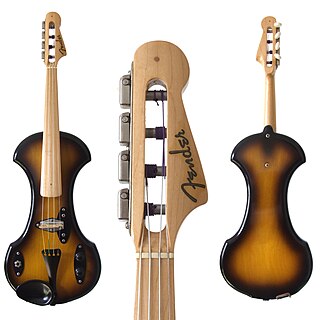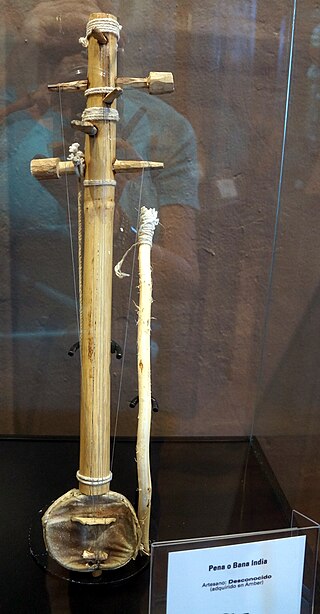Related Research Articles

A fiddle is a bowed string musical instrument, most often a violin. It is a colloquial term for the violin, used by players in all genres, including classical music. Although in many cases violins and fiddles are essentially synonymous, the style of the music played may determine specific construction differences between fiddles and classical violins. For example, fiddles may optionally be set up with a bridge with a flatter arch to reduce the range of bow-arm motion needed for techniques such as the double shuffle, a form of bariolage involving rapid alternation between pairs of adjacent strings. To produce a "brighter" tone than the deep tones of gut or synthetic core strings, fiddlers often use steel strings. The fiddle is part of many traditional (folk) styles, which are typically aural traditions—taught "by ear" rather than via written music.

The violin, colloquially known as a fiddle, is a wooden chordophone, and is the smallest, and thus highest-pitched instrument (soprano) in regular use in the violin family. Smaller violin-type instruments exist, including the violino piccolo and the pochette, but these are virtually unused. Most violins have a hollow wooden body, and commonly have four strings, usually tuned in perfect fifths with notes G3, D4, A4, E5, and are most commonly played by drawing a bow across the strings. The violin can also be played by plucking the strings with the fingers (pizzicato) and, in specialized cases, by striking the strings with the wooden side of the bow.

In musical instrument classification, string instruments or chordophones, are musical instruments that produce sound from vibrating strings when a performer plays or sounds the strings in some manner.

The rebec is a bowed stringed instrument of the Medieval era and the early Renaissance. In its most common form, it has a narrow boat-shaped body and one to five strings.

The crwth, also called a crowd or rote or crotta, is a bowed lyre, a type of stringed instrument, associated particularly with Welsh music, now archaic but once widely played in Europe. Four historical examples have survived and are to be found in St Fagans National Museum of History (Cardiff); National Library of Wales (Aberystwyth); Warrington Museum & Art Gallery; and the Museum of Fine Arts, Boston (US).
The music of Sri Lanka has its roots in five primary influences: ancient folk rituals, Hindu religious traditions, Buddhist religious traditions, the legacy of European colonisation, and the commercial and historical influence of nearby Indian culture—specifically, Kollywood cinema and Bollywood cinema.

Stemming from Sweden, the nyckelharpa, meaning "keyed fiddle" or "key harp"(lit.), is a bowed chordophone, similar in appearance to a fiddle or violin, which employs key-actuated tangents along the neck to change the pitch during play, much like a hurdy-gurdy. The keys slide under the strings, with the tangents set perpendicularly to the keys, reaching above the strings. Upon key-actuation, the tangent is pressed to meet the corresponding string, much like a fret, shortening its vibrating length to that point, changing the pitch of the string. It is primarily played underarm, suspended from the shoulder using a sling, with the bow in the overhanging arm.

The erhu is a Chinese two-stringed bowed musical instrument, more specifically a spike fiddle, which may also be called a Southern Fiddle, and is sometimes known in the Western world as the Chinese violin or a Chinese two-stringed fiddle.

An electric violin is a violin equipped with an electronic output of its sound. The term most properly refers to an instrument intentionally made to be electrified with built-in pickups, usually with a solid body. It can also refer to a violin fitted with an electric pickup of some type, although "amplified violin" or "electro-acoustic violin" are more accurate then.

The rebab is the name of several related string instruments that independently spread via Islamic trading routes over much of North Africa, Southeast Asia, the Middle East, and parts of Europe. The instrument is typically bowed, but is sometimes plucked. It is one of the earliest known bowed instruments, named no later than the 8th century, and is the parent of many bowed and stringed instruments.

The bladder fiddle was a folk instrument used throughout Europe and in the Americas. The instrument was originally a simple large stringed fiddle made with a long stick, one or more thick gut strings, and a pig's-bladder resonator. It was bowed with either a notched stick or a horsehair bow.

A ravanahaththa was an ancient bowed, stringed instrument, used in the Indian subcontinent, Sri Lanka, and surrounding areas in South Asia. It has been suggested as an ancestor of the violin.

Dinesh Subasinghe is a Sri Lankan composer, violinist, and music producer. He composed Karuna Nadee, a Buddhist oratorio, and re-introduced a lost, ancient musical instrument known as the ravanahatha to Sri Lanka. He is also a film and television composer whose works integrate western and eastern classical music with electronic music, Buddhist music, folk music, traditional orchestral arrangements, and world music genres. From 2002 to 2009 he led the pop classical band, Dee R Cee Members.
The Kemençe of the Black Sea is a Greek and Turkish traditional musical instrument. It belongs to the category of stringed bowed musical instruments. It has three strings, usually tuned to perfect fourths, usually tuned B-E-A. It is the pre-eminent musical folk instrument of the Greeks of Pontus. It seems to have been invented during the Byzantine years, between the 11th and 12th centuries. The instrument is made of different types of wood.
Bibiladeniye Mahanama Thero is a Buddhist monk of the Theravada Order. The thero is the only Buddhist priest in Asia of the Theravada order to actively engage in the experimentation and the creative exploration of music as a form of aesthetic expression. The thero has been actively engaged with the art, both on overseas projects as well as in Sri Lanka for nearly two decades.
This is the discography of Dinesh Subasinghe, a Sri Lankan composer, violinist, instrumentalist, music director and record producer, who has released three solo studio albums. Subasinghe has also released seven music videos, including four with his music group Dee R Cee.
"E Kale the One" is single composed by Dinesh Subasinghe featuring Charmika Sirimanne.
Siri Sirimal is a Sri Lankan television series directed by Sunil Costha that aired on Rupavahini from 2007 to 2008. It was adapted from Mark Twain's 1876 novel The Adventures of Tom Sawyer. The theme song and sound track for the series were composed by Dinesh Subasinghe.

WarigaPojja is a 2014 Sri Lankan adventure film, directed by Thushara Thennakoon and produced by the Sri Lanka Women's Development Services Cooperative Society Ltd. It stars Nadeesha Nilukshi and Jagath Manuwarna in lead roles along with Somaweera Gamage and Nayana Hettiarachchi. Music composed by Dinesh Subasinghe.
References
- ↑ "kingri". Digitalstamp.suppa.jp. Retrieved 2013-12-05.
- ↑ "Soul's Journey". www.santmat-thetruth.de. Archived from the original on 2013-12-11. Retrieved 2013-12-05.
- ↑ "The Fourfold Heritage (Music of Punjab)". Sikh-heritage.co.uk. Retrieved 2013-12-06.
- ↑ "Kingri in India". India9.com. 2005-06-07. Retrieved 2013-12-05.
- ↑ ":: Daily Mirror – Opinion ::". Archives.dailymirror.lk. 2007-11-25. Archived from the original on 2013-04-02. Retrieved 2013-12-05.
- ↑ "Creative tunes". Sundaytimes.lk. 2008-01-13. Retrieved 2013-12-05.
- ↑ This refers to the following book: Abele and Niederheitmann, The Violin: Its History & Construction, Illustrated & described, From Many Sources. London: William Reeves, 1900–1930. Translated by John Broadhouse.